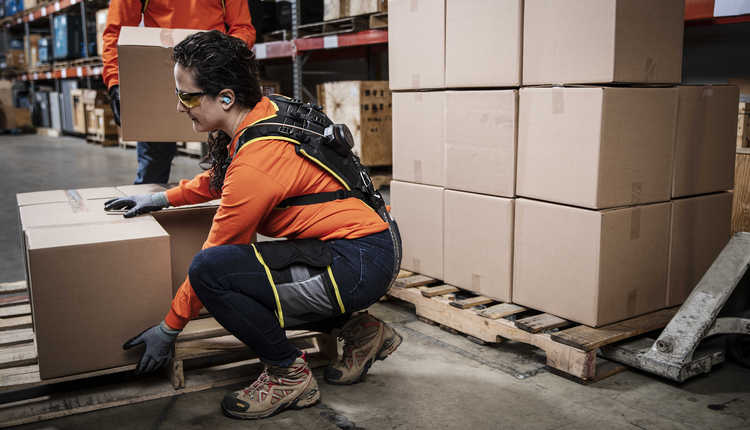We now live in the Online Shopping Era. The e-commerce transformation of the past two decades – especially the past five years – has translated to last-mile vehicles popping up on seemingly every street in the country. Shipping logistics companies must constantly find ways to keep up with growing demand caused by e-commerce trends that have shown little signs of slowing down.
Online sales are projected to increase to $4.5 trillion by 2021 – more than three times what they were in 2014. According to the World Economic Forum, there’s expected to be a 78% increase in urban last-mile deliveries through 2030.
As recent reports have shown, one of the major challenges presented by this accelerating business is keeping workers safe. Companies are approaching this problem differently, and some are using something that sounds out of a sci-fi movie: Exoskeletons.
No, exoskeletons are not just for Sigourney Weaver fighting off aliens or Robert Downey Jr. saving the world as Iron Man.
Exoskeletons Are Here (And Here to Stay)
Modern exoskeletons are a lightweight, simple to use, and non-invasive way to help logistics workers keep up with ever-increasing demand. The approachability and adaptability of exosuits (which are “soft shell,” textile-based exoskeletons) are major drivers behind the growth of exos in shipping, logistics, and other industries.
In the past few years, several forward-thinking companies have been early adopters of exoskeleton technology. Geodis, a Dutch-based logistics company, began implementing passive (non-motorized) exoskeletons for back support in 2017.
DHL published a report saying that soon, packages “will still be delivered to our homes by human employees but they will be using exoskeletons to safely lift heavy weights.” The famed logistics company, which recently tested exosuits in Germany, said that the rise of robotics and exoskeleton technology go hand-in-hand.
It’s not only in the test phase, either. Toyota has been using exoskeletons at plants since 2015 – including recently making them mandatory Personal Protective Equipment in a plant in Indiana. Other major corporations, such as Ford and Boeing, have also added exoskeletons to their operational toolbox.
Companies use the comfortable, lighter-weight exosuits as a way to combat the fatigue, strain, and other risks that lead to musculoskeletal disorders for workers – which helps operations tackle a billion-dollar problem in the process.
Affordable equipment to help solve a $1 billion-per-week problem
Non-battery powered, non-motorized exosuits help create a safer workspace and combat the costs associated with overexertion and repetitive motion injuries. The Centers for Disease Control and Prevention (CDC) reported recently that back pain is the most prevalent work-related health problem and Liberty Mutual estimates that employers pay nearly $1 billion per week for direct workers’ compensation.
Back-assist exosuits can take 30% of the load off a worker’s back for a price that doesn’t break the bank, thanks to recent advances. Exosuit manufacturers with strong customer support, training, and implementation programs can help any organization make the most of their new technology adoption.
Finding the Truth in Misconceptions
Because they are still relatively new to the market, there are some common misconceptions about exosuits: that they are bulky, limit range of motion, or cause muscle atrophy.
The truth is modern passive exos on the market are lightweight and practical.
There are exosuits made up of cables, pulleys, springs, and aluminum tubing, and others that are largely fabric and weigh less than 4 pounds – but still provide protection for the user.
As for muscle atrophy, it can actually occur when there is too little or too much muscle activation. That means overexertion can lead to muscle atrophy, as can the lack of muscle use after an injury as well. The purpose of exosuits is to keep workers in that healthier “sweet spot.”
Modern exosuits are also not turning workers into human forklifts. Passive exosuits help workers with lifting, bending, and reaching during a shift. Those 25-pounds boxes are still being lifted and moved, but exosuits can make it feel like they're only lifting a 15-pound box. That’s still plenty of work, but it makes a significant difference over the course of a workday and a career.
In practice, exosuits should be viewed as a significant addition to the Personal Protective Equipment portion of the National Institute for Occupational Safety and Health’s (NIOSH) Hierarchy of Controls. If all other steps in the Hierarchy can’t eliminate the risk, exosuits help reduce the strain and fatigue that causes injuries.
So where to begin? There is a wealth of information now available about the recent advancements in exosuits on sites like ExoskeletonReport.com.
Exosuits help workers keep up with demand
The increased demands due to online shopping aren’t going away. The toothpaste is out of the tube, so to speak. It’s up to shipping logistics operations to keep up and protect active workers who are lifting, bending, and reaching all day.
Thankfully, while technology has made shopping easier for the consumer, that same progression has also supplied shipping logistics operations tools to help alleviate some of the stress.
Those sci-fi images of exoskeletons giving people superhuman strength are great for a box-office blockbuster. However, the truth is exosuits are actively being used to help workers do their job safer, longer, and more efficiently. And the benefits aren’t just realized on the last mile. They allow workers to keep their energy to enjoy life outside of work which can translate to happier workers and higher retention of valued employees.
Exoskeletons don’t just help workers do their jobs better. Now it's never been easier to implement exosuits to help logistics businesses succeed and help their workers live better.
Matt Marino is the Director of Ergonomics and Human Factors at HeroWear. Matt has been an active member of the ASTM F48 Committee on Exoskeletons since its inception, and is a founding partner of the ASTM Exo Technology Center of Excellence. Matt is a Physical Therapist, Certified Professional Ergonomist, and an expert in fitness, health, and human performance optimization. HeroWear designs and manufactures exoskeleton technology for working men and women who lift every day. For more information on HeroWear, visit www.herowearexo.com.















